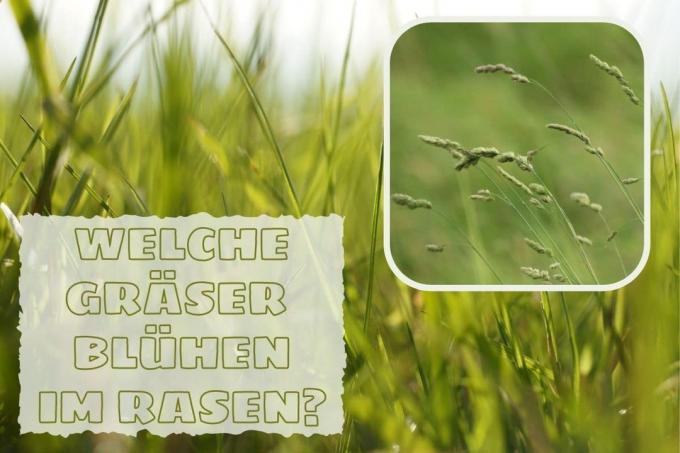
table of contents
- Unwanted flowering foreign grasses
- Desired flowering lawn grasses
- frequently asked Questions
Even if the soil is optimally prepared, the race again and again unwanted, but also some useful flowering foreign grasses. As a rule, this cannot be prevented. What to do when the lawn is in bloom
In a nutshell
- frequent occurrence can be attributed to incorrect or insufficient lawn care
- Fighting is difficult in most cases
- The spread of these unwanted grasses is difficult to stop
- Removal is only possible manually in most cases
Unwanted flowering foreign grasses
Blood-red foxglove (Digitaria sanguinalis)

- about 50 cm high sweet grass
- initially prostrate, later kinking and ascending, loosely hairy
- is considered to be the host for migratory root nematodes
- Leaf blades finely silky, whitish-reddish central nerve
- Lawn blooms in summer and early fall
- three to seven loose false ears
- Lawn strong at first fertilize
- and / or scarify flat in early summer
- Millet stands up, mow down with a deep cut
- Regular fertilization and reseeding, keep the sod tight
- or cut out before flowering
Annual bluegrass (Poa Annua)
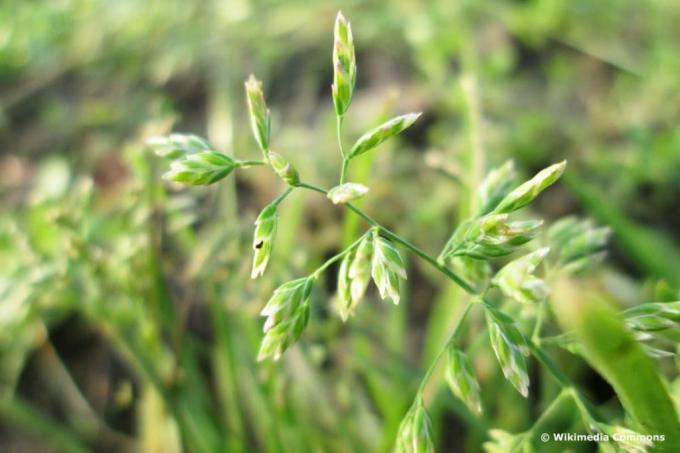
- inconspicuous, low, light green-yellowish grass
- colonizes bald spots and gaps almost overnight
- occurs from April to June
- light green stalks with paniculate, almost white flowers
- rarely longer than two inches
- Spikelets green, rarely coated with purple
- when the lawn is in bloom, fertilize in May and June
- less often therefor abundantly water
- Combat by manual gouge
- mow only with the grass catcher
- Robotic lawn mowers favor the spread of these grasses
Tip: The flower panicles including seeds form all summer long when the weather is good. The annual bluegrass is also a good indicator of nitrogen.
Common panicle (Poa trivialis)
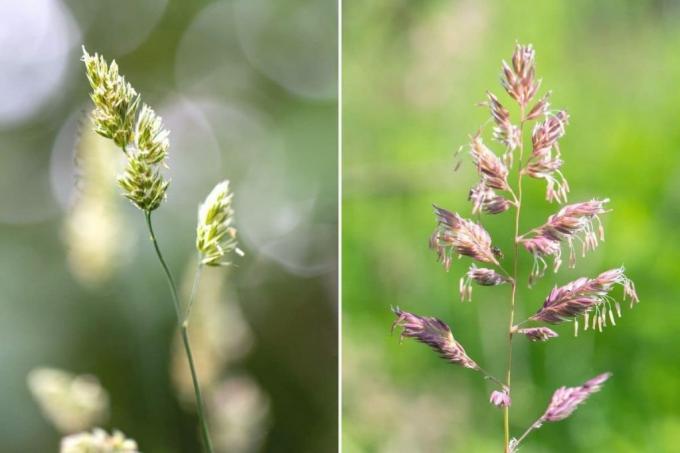
- grows before all other grasses in spring
- easily confused with millet
- prefers on damp and wet soils
- roots only superficially
- Lawn blooms from June to July
- leaves light green in spring
- later reddish stem base visible
- the older the scruffier the growth
- turns reddish-brown when dry and dies
- leaves unsightly bald spots
- Control is similar to that of annual bluegrass
Green millet (Setaria viridis)

- flowering grasses with heights of 5 to 50 cm
- kinking stalks
- very thin, not hairy
- Leaves green with a pale or purple central vein
- Lawn blooms from summer to early autumn
- Flower spikes smooth when brushed over
- compact, not interrupted
- Bristles thin, long, soft, green, later blending into purple
Note: Millet is particularly evident in patchy lawns and New seeds as well as at ground temperatures from 20 degrees. It dies at temperatures below 15 degrees and less than 12 hours of light.
Dog tooth grass (Cynodon dactylon)
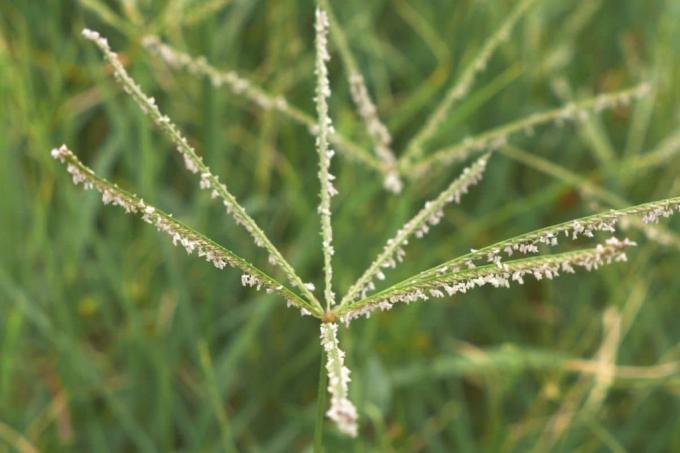
- perennial flowering grasses, about 30 cm high
- up to one meter long, branched rhizome
- often forms dense lawns
- Culms slender, lying, with adventitious roots and side shoots
- strong competitor for water
- blooms in the lawn from summer to autumn, all year round in warm locations
- up to seven ears arranged like fingers
- hard to get out of the lawn
Note: Control is only possible selectively by hand or over a large area using total herbicides (we expressly reject the use of this here).
Chicken millet (Echinochloa crus-galli)

- Flowering grasses up to 80 cm high
- kinking upright or ascending stalks
- hairy at the nodes
- Leaves dark, gray-green, relatively broad
- Central nerve whitish, youngest leaf rolled
- Lawn blooms from July to September
- Inflorescence, compound panicle
- spike-like partial inflorescences, overflowing light green or purple
Couch grass (elymus)

- grows faster than grasses made from lawn mixes
- persistent, extensive underground foothills
- Leaves deep green, shimmering bluish
- tall shoots, different directions of growth, 50 to 120 cm high
- Flowering from June to August
- slender, spiked inflorescences, 5 to 20 cm long
- It is difficult to get rid of couch grass
- Pick out regrowing plants immediately after emergence
- if possible with a complete root
White ostrich grass (Agrostis stolonifera)

- evergreen, perennial, 8 to 40 cm high
- forms a dense and soft carpet in the lawn
- leafy aboveground runners
- Leaves glabrous, finely pointed, gray to blue-green
- smooth, bald, branchy stalks, two to five knots
- on lower nodes, shoots and sprouted roots
- blooms in the lawn between July and August
- elongated panicle inflorescences
- Spikelets in dense clusters
Note: Even if the ostrich grass is nice to look at, it is neither particularly resistant to treading nor shear. By frequent Scarifying it is also stimulated to grow.
Desired flowering lawn grasses
German ryegrass (Lolium perenne)

- in Lawn seeds-Mixes very popular
- hard-wearing, lush green flowering grasses
- Fast-growing, clump-forming, around 20 cm high
- grow particularly well in nitrogen-rich soils
- Lawn blooms from May to autumn
- Flower stalks approx. 70 cm high
- the colder, the more vulnerable
- regular mowing stimulates growth
Attention: The German ryegrass is one of the most common pathogens for hay fever in this country.
Red fescue (Festuca rubra)
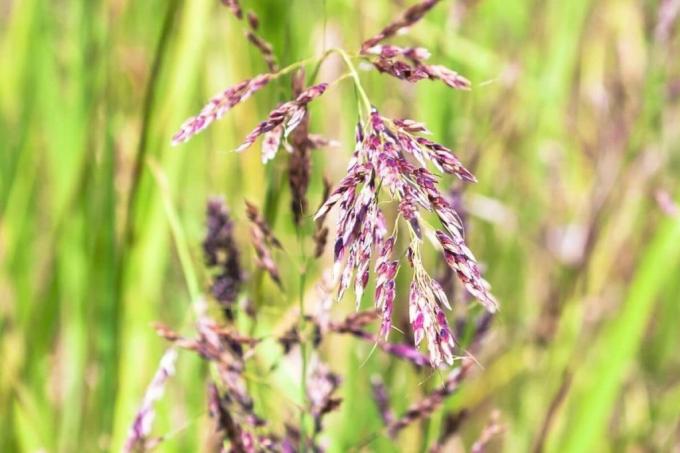
- Often contained in high-quality lawn mixes
- perennial, runners or clumps forming, undemanding
- Heights between 20 and 80 cm
- steep upright stalks
- Leaf sheaths almost completely closed
- blooms in the lawn from April to October
- upright, sparsely branched panicles
- Conditions may vary depending on the subspecies
frequently asked Questions
Unwanted grasses can settle and spread more easily the more negligent you are in maintaining the lawn. If the lawn becomes patchy, they can spread out very easily. A dense, closed sward is all the more important. Some of these flowering grasses are often also found in lawn seed mixtures.
As a rule, reseeding can be carried out during the entire growing season. If the lawn is to be completely re-laid due to the presence of too many foreign grasses, spring or early autumn are ideal.
One cannot completely prevent the settlement of these grasses. Nevertheless, with the right lawn care you can counteract uncontrolled spread. This includes in particular targeted irrigation and long dry phases as well as correct fertilization and regular, at best weekly mowing. In some cases, by superficial scarifying, seeds that are already beginning to germinate in the ground can be rendered harmless.
